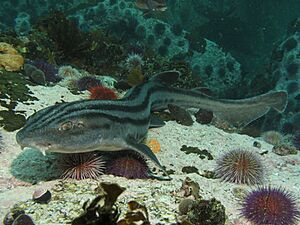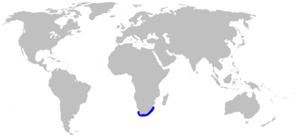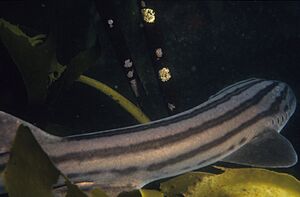Pyjama shark facts for kids
Quick facts for kids Pyjama shark |
|
|---|---|
 |
|
| Conservation status | |
| Scientific classification | |
| Genus: |
Poroderma
|
| Species: |
africanum
|
 |
|
| Range of the pyjama shark | |
| Synonyms | |
|
Squalus africanus Gmelin, 1789 |
|
The pyjama shark or striped catshark (Poroderma africanum) is a type of catshark. It belongs to the family called Scyliorhinidae. This shark lives only in the coastal waters of South Africa. It is a very common bottom-dwelling shark.
You can find pyjama sharks from the intertidal zone (where the ocean meets land) down to about 330 feet (100 meters) deep. They especially like rocky reefs and kelp beds. This shark is easy to spot because it has thick, dark stripes along its body. It also has a short head and snout with two thin barbels (whisker-like feelers) near its mouth. Its two dorsal fins are located far back on its body. A pyjama shark can grow up to 3.6 feet (1.1 meters) long.
Pyjama sharks are mostly active at night. During the day, they usually rest hidden in caves, cracks, or among plants. They often gather in groups, especially in summer. These sharks are predators that eat many different fishes and invertebrates (animals without backbones). They really like cephalopods like squid and octopus. When they feel threatened, they curl into a circle, covering their head with their tail. Female pyjama sharks lay rectangular, dark brown egg cases two at a time all year long. This small, harmless shark does well in aquariums and is often seen in public aquariums. Fishermen sometimes catch them by accident, but their numbers are stable. The International Union for Conservation of Nature (IUCN) lists the pyjama shark as "least concern."
Contents
What is a Pyjama Shark?
The pyjama shark was first described in 1789 by a German naturalist named Johann Friedrich Gmelin. He called it Squalus africanus. Later, in 1837, a Scottish zoologist named Andrew Smith created a new group, or genus, called Poroderma for this shark. In 1908, the pyjama shark became the main example, or type species, for the Poroderma genus.
Where Pyjama Sharks Live
The pyjama shark lives on the bottom of the ocean in cool, shallow waters. You can find them off the coast of South Africa. Their range stretches from Table Bay near Cape Town to north of East London. They are most common off the Western Cape.
These sharks are often found in very shallow waters, less than 16 feet (5 meters) deep. However, in places like Algoa Bay, they can be found deeper, from 160 to 330 feet (50 to 100 meters). They like areas with rocky reefs and beds of Ecklonia kelp (a type of large seaweed).
How to Identify a Pyjama Shark
The pyjama shark is the larger of the two Poroderma species. It can grow up to 3.6 feet (1.1 meters) long and weigh 17.4 pounds (7.9 kg) or more. Males and females grow to about the same size.
Its head and snout are short and a bit flat. Each nostril has a small flap of skin with a long, cone-shaped barbel. These barbels are thicker than those on the leopard catshark and do not reach the mouth. The eyes are oval and set high on the head. They have a small protective third eyelid. The mouth is wide with short grooves at the corners. It has many rows of small teeth, each with a slender point and two smaller points on the sides.
The shark's body is somewhat flat from side to side. Its two dorsal fins are located far back on its body. The first dorsal fin is much bigger than the second. The pectoral fins are large and wide. The pelvic fins are smaller than the pectorals. Adult males have short, thick claspers used for reproduction. The tail fin is short and wide.
The skin is very thick and covered in small, hard dermal denticles (like tiny teeth). The most striking feature is its color: it has 5 to 7 thick, dark stripes running from its snout to its tail. These stripes are on a grayish or brownish background. The stripes might break up near the tail, or some sharks might have large dark spots. The underside of the shark is pale. Young sharks look similar to adults but might have lighter or darker stripes.
Life and Habits of the Pyjama Shark
Behavior and Diet
Pyjama sharks are slow swimmers. They spend most of the day resting in caves, cracks, or among kelp. At night, they become active and hunt for food. Many pyjama sharks might gather in one spot, especially during summer. Larger sharks, like the broadnose sevengill shark, sometimes eat pyjama sharks.
When a pyjama shark feels threatened, it often curls into a circle. It covers its head with its tail, similar to how shysharks behave. The eggs of pyjama sharks can be eaten by whelks (sea snails). These snails can even poke through the egg case to get to the yolk inside.
Pyjama sharks eat many different small animals. Their diet includes bony fishes like anchovies and hakes, hagfishes, smaller sharks and rays (and their egg cases), crustaceans (like crabs), cephalopods (like squid and octopus), and polychaete worms. They also sometimes eat fish scraps. While they love cephalopods, what they eat mostly depends on what food is available nearby. For example, in False Bay, Cape rock lobster is their main food.
Pyjama sharks have been seen grabbing and tearing off tentacles from octopus and cuttlefish by twisting. Sometimes, three sharks will attack an octopus at the same time. When chokka squid lay their eggs in large groups, pyjama sharks change their habits. They gather in big numbers during the day in the squid's "egg beds." The sharks hide their heads among the egg masses. Their stripes help them blend in. As female squid go to the seafloor to lay eggs, male squid guard them. This makes the squid easy targets for the hidden sharks.
Reproduction and Life Cycle
Pyjama sharks reproduce by laying eggs. Both male and female sharks seem to be ready to reproduce all year. Female sharks have one working ovary and two working oviducts. They usually have one egg maturing in each at a time.
The egg is inside a tough, rectangular, dark brown capsule. It is about 3.7 inches (9.5 cm) long and 1.8 inches (4.5 cm) wide. The capsule has long tendrils at its corners. These tendrils help the female attach the capsule to things underwater. She might attach it to algae stems or gorgonians (a type of coral). Eggs kept in aquariums hatch in about five and a half months. The baby shark that hatches is usually 5.5 to 5.9 inches (14 to 15 cm) long.
Male pyjama sharks become mature when they are about 30.7 to 31.9 inches (78 to 81 cm) long. Females mature when they are about 31.1 to 32.7 inches (79 to 83 cm) long. All pyjama sharks are adults by the time they reach 35 inches (89 cm) in length.
Pyjama Sharks and People
The pyjama shark is one of the most common catsharks in South Africa. It is harmless to humans and hard to get close to underwater. Because it is small, attractive, and tough, it is popular in public aquariums. There is a small fishing industry that catches these sharks for aquariums.
Many pyjama sharks are caught by accident by commercial fishermen. They use different fishing methods like longlines, gillnets, and bottom trawls. Recreational fishermen also catch them easily, especially in summer when they gather together. Even though they are edible, most caught sharks are thrown back. Some are used as bait for lobsters.
The number of sharks caught by accident is probably much higher than we think. Many fishermen who use lines see pyjama sharks as pests that "steal" bait. They often kill the sharks before throwing them back.
The International Union for Conservation of Nature (IUCN) has listed the pyjama shark as "least concern." This means they are not currently at high risk of disappearing. This is despite their small living area and more fishing pressure on small sharks in the region. There is no proof that their population has gone down. There are no special rules to protect this shark. However, some of its living areas are inside marine protected zones. The South African Sea Fisheries Research Institute is thinking about making it illegal to fish for pyjama sharks for commercial purposes. This would limit how much commercial fishermen can target them.
Images for kids







